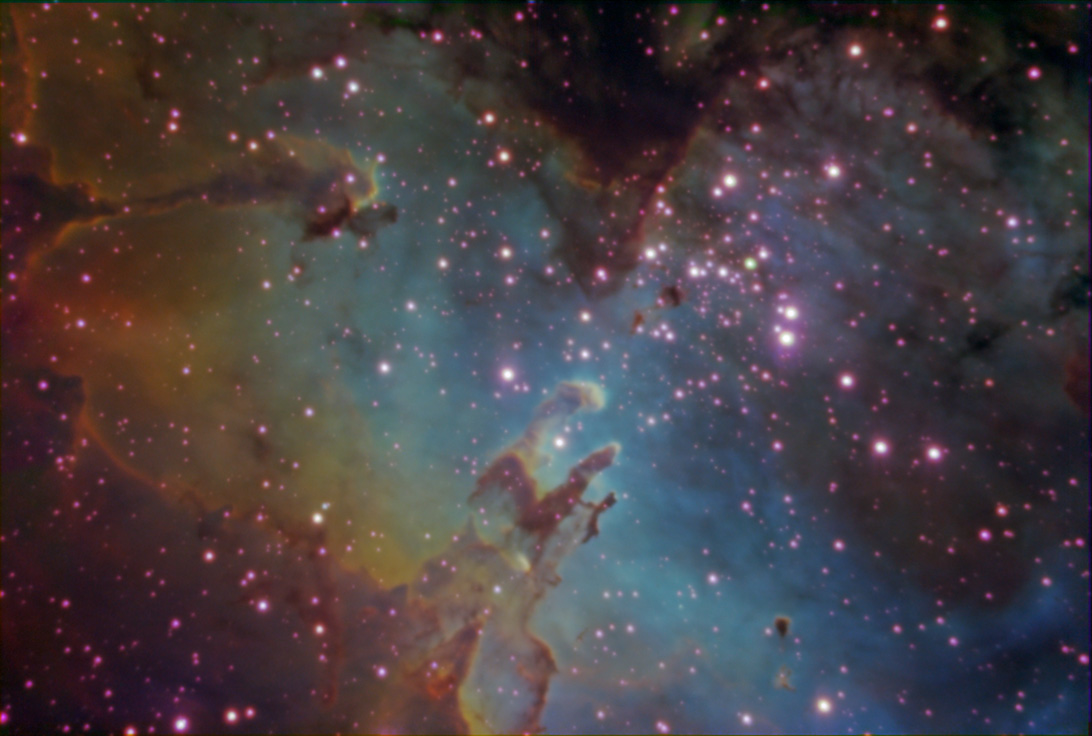M16 - Eagle Nebula [SII]:Ha:[OIII]

For high resolution, click here.
M16 - Eagle Nebula [SII]:Ha:[OIII]: The Eagle Nebula, which includes the "Pillars of Creation" are imaged here in [SII], H-alpha and [OIII], in a color mapping made famous by the Hubble image of this object. In star forming regions, gravity pulls together clumps from the cloud of gas that collapse and form the stars. The first stars that form are the massive, bright blue stars near the center of the cluster. These emit lots of ultraviolet light that then excites the gas in the surrounding clouds. The intense radiation from these same stars is also "blowing away" the clouds - in direct competition with gravity. These competing forces give the "melting candle wax" appearance of parts of this nebula. The emission lines indicate the presence of Sulphur (red), Hydrogen (green) and Oxygen (blue) in the clouds.
Messier: 16
NGC: 6611
Right Ascension: 18h 18.8m
Declination: -13° 47'
Apparent Magnitude: 6.4
Date: August 2010
Equipment:
Telescope: Meade 16" Schmidt Cassegrain
Camera: SBIG ST-10XE
Guiding: AO-8
3nm Astrodon H-a filter
6nm Astrodon [OIII] filter
6nm Astrodon [SII] filter
Exposure: [SII] (red): 11x10 minutes binned 2x2
H-alpha (green): 9x10 minutes binned 2x2
[OIII] (blue): 9x10 minutes binned 2x2
Clear (Luminance 40%): 60x30 seconds binned 1x1
The camera was at -35°C for the narrow band images, and -30°C for the Luminance.
Processing Notes: Data acquisition with CCDSoft. Reduced and aligned in CCDStack. Subs combined in Sigma Beta. Individual channels were imported into Photoshop and processed separately. Adjusted curves and levels. Slight noise reduction on the dim areas and sharpening on non-star bright areas. A highpass filter of the non-star regions was overlayed to increase contrast. Slight minimum filter on the brighter stars in the [SII] and [OIII] channels. Narrowband channels were then combined in Photoshop. Luminance (processed independently) was combined with the narrow band data using three layers: Luminance (40%) on the bottom; desaturated combined narrowband as a multiply(40%) layer; and combined narrow band as a color layer on top. Final stretch and tweak in Photoshop.
Scale: 1.05"/pixel
Links to images of this object on other sites:
http://antwrp.gsfc.nasa.gov/apod/ap070218.html
http://www.astrocruise.com/milky_way/M16_02.htm
http://www.narrowbandimaging.com/images/m16_ap180_cm10_s2hao3_15x20min_xga.jpg
Additional Comments: One concern with processing was the challenge of getting the stars to be the same size in the various channels. This was especially challenging with the aberrations near the edges. The seeing (more likely just wind motion) for the [SII] data was significantly below average. Seeing for the other data was average, or slightly above average. FWHM of the stars near the center of the L data was under 3". This might be improved with more care with collimation.
A narrowband version of the Eagle nebula from 2008 can be found here: http://www.fortlewis.edu/observatory/image_detail.asp?ID=50 Numerous other Eagle Nebula images can be found by searching this site for M16. The FIT files will be made available from the resources page.
Views: 12850
 This work is licensed under a Creative Commons Attribution-NonCommercial-ShareAlike 4.0 International License.
This work is licensed under a Creative Commons Attribution-NonCommercial-ShareAlike 4.0 International License.

